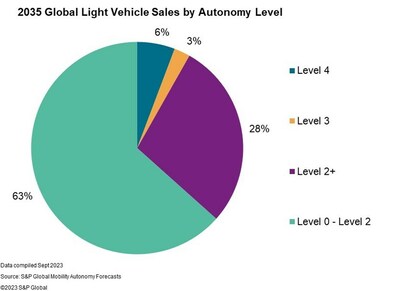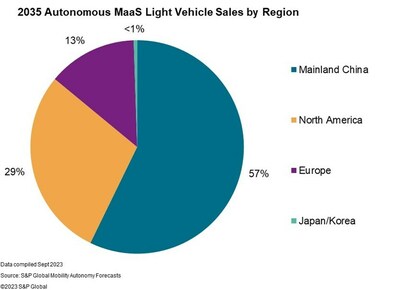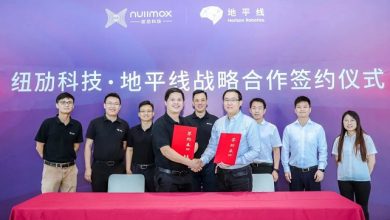Widespread autonomous vehicle adoption a decade away

SOUTHFIELD, Mich., Sept. 25, 2023 /PRNewswire/ — A world of self-driving vehicles and mobility-on-demand is likely to exist eventually, but for the next decade, widespread implementation of autonomous technology will not be realized, according to a new forecast from S&P Global Mobility. The report reflects findings from robust model-level forecasting. Expectations for autonomous vehicles have not met their full potential and continue to encounter additional challenges, offering significant opportunities and scalability for the interim implementation of automated driving.

For the next decade, autonomous tech will be limited to two specific areas. The first is geofenced robotaxis operated by fleets in specific areas. The second is hands-off systems with various safeguards in personal vehicles that will still require some form of driver engagement.
The latest forecast from S&P Global Mobility notes that Level 5 Autonomy – “A vehicle that can go anywhere and do everything a human driver can,” will not be publicly available before 2035, “and probably for some time after that,” stated Jeremy Carlson, associate director for the autonomy practice at S&P Global Mobility. “The outlook for more targeted implementations of the same fundamental technologies, especially in Level 2+ and Level 3, is more positive. Additionally, this progress will certainly happen on a much shorter timeline, even for some forms of Level 4.”
This latest outlook from S & P Global Mobility reflects the headwinds and slower pace of development. Both the automotive and tech industries have demonstrated over the past several years. It paints a stark contrast to the optimism of just five years ago. The promise and excitement of a future of self-driving vehicles in Levels 4 and 5 swept up the world. Now, S&P Global Mobility presents a more realistic outlook amid this moderated pace of progress while also publishing new data on the intersection of autonomy and mobility-as-a-service (MaaS).

Automated – rather than autonomous – driving continues to be the focus of industry development. Today’s broad deployments of Level 2+ and Level 3 systems by many automakers in multiple regions will reach at least 31% of new vehicle sales globally by 2035, according to the forecast. L2+ and L3 allow the driver to be hands-off while supervising. They can also disengage entirely in specific driving scenarios, such as in Super Cruise by General Motors and Drive Pilot by Mercedes-Benz, respectively.
“There is immense opportunity for automated driving systems in L2, and L3. They are benefiting from the standardization of basic safety features which provide a foundation of in-vehicle architecture, sensing, and compute,” Carlson says. “Their functionality also complements driving today rather than fully replacing the driver, making consumer adoption less of a challenge. The next several years will be a boon for automakers selling these optional features. It will also benefit suppliers who continue to build scale and a strong foundation for the future.”
L4 Technology Slow to Develop in Personal Vehicles – MaaS Robotaxis to Lead the Way
The S&P Global Mobility forecast predicts that fewer than 6% of light vehicles sold in 2035 will have any Level 4 functionality. This functionality is described by the SAE J3016 classification. Early L4 implementations in personally-owned vehicles offer advanced parking functions, often with the support of infrastructure. But many technology providers remain focused on the long-term potential of scaling autonomous vehicles in fleets supporting MaaS business models.
There are positive examples of autonomous vehicles performing as well as humans in today’s pilot programs. These programs are taking place in locations such as San Francisco and Phoenix in the US, as well as Beijing, Shanghai, and Guangzhou in Mainland China. These same vehicles can still be confounded by complex traffic scenarios the next minute. The next day, they can also present challenges, giving regulators and consumers alike reason to be cautious.
Mobility-as-a-Service (MaaS) expects to lead the transition to an autonomous vehicle future. Robotaxis are also anticipates to play a significant role, despite the relatively cautious growth ahead. There are growing numbers of small-scale deployments in certain cities around the world. But S&P Global Mobility forecasters do not expect that to become widespread and broadly accessible within the next decade.
In 2035, we expect MaaS-equipped vehicles and robotaxi applications to account for fewer than 800,000 vehicles sold globally. Robotaxis will be carefully geofenced for the foreseeable future. Carlson predicts that the revenue service will only operate within specific areas where they have already extensively tested it. Their high rate of utilization can be effective at bringing new mobility options to some consumers. It can also create new revenue streams for automakers and mobility providers.
Owen Chen, senior principal analyst from S&P Global Mobility, explains that robotaxi development and commercialization is a complex and multi-stage process. This process can be summarized in three stages. First, technical feasibility demonstrations confirm that robotaxis can operate safely and reliably in the targeted conditions. Second, the long process of technology optimization, integration, and refining vehicle design eventually brings scale to manufacturing and deployment. Third is the efficient expansion to many new locations and operating conditions. It profit on top of revenue from meaningful adoption by consumers. Chen adds that, “In 2023, many are working through stage 1 while several are seeking scale in stage 2, led by Mainland China and the US. But the opportunity to restructure personal and shared mobility exists.”
In August, the California Public Utility Commission approved an expansion of operations in San Francisco for Waymo and Cruise. Mainland Chinese regulators are enabling providers like Baidu Apollo, Pony AI, WeRide, and more to test their services. They can also operate paid services in parts of many major Chinese cities. Europe is also actively developing regulations to help bring some uniformity to such vehicles and services across the region.
The US captured an early lead in both development and deployment of L4 MaaS. Long-term expectations predict that mainland China will contribute the greatest volumes. S&P Global Mobility reports that the US and Europe follow this order.
Challenges nonetheless remain for successful and widespread deployment of L4 MaaS. A fragmented regulatory landscape and relatively low public trust trust can hinder consumer acceptance and adoption. The cost of technology and the time required for robust hardware and software development and validation have dampened the optimism of the last decade. These factors together pose significant challenges to the advancement of this technology.
Reduced complexity in L2+ and L3 features face less risk or uncertainty for each of these factors. Hence the more positive outlook for those technologies in the short term. Optimism increases further because some regulators are also mandating certain basic safety assistance features that will generate even wider exposure for selective automation.
Automakers, suppliers, technology companies and mobility providers alike. However, remain committed to a future of safe and equitable autonomous mobility, even if it takes more time to get there.
“There’s plenty of opportunity and growth ahead,” says Carlson. “Significant volumes measured in the hundreds of thousands per year are quite likely to come before 2030—but a future of shared mobility everywhere all the time will remain an aspiration for the industry.”
For the full report, click here.




